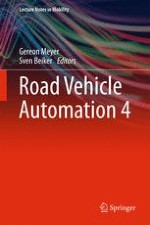2018 | OriginalPaper | Chapter
Potential Fleet Size of Private Autonomous Vehicles in Germany and the US
Authors : Stefan Trommer, Lars Kröger, Tobias Kuhnimhof
Published in: Road Vehicle Automation 4
Publisher: Springer International Publishing
Activate our intelligent search to find suitable subject content or patents.
Select sections of text to find matching patents with Artificial Intelligence. powered by
Select sections of text to find additional relevant content using AI-assisted search. powered by
